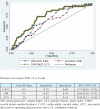Screening Validity of Arterial Pressure-Volume Index and Arterial Velocity-Pulse Index for Preclinical Atherosclerosis in Japanese Community-Dwelling Adults: the Nagasaki Islands Study
- PMID: 29398680
- PMCID: PMC6143774
- DOI: 10.5551/jat.43125
Screening Validity of Arterial Pressure-Volume Index and Arterial Velocity-Pulse Index for Preclinical Atherosclerosis in Japanese Community-Dwelling Adults: the Nagasaki Islands Study
Abstract
Aim: The arterial pressure-volume index (API) and arterial velocity-pulse index (AVI) are novel measurement indices of arterial stiffness. This study was performed to examine the screening validity of the API and AVI for preclinical atherosclerosis in Japanese community-dwelling adults.
Methods: We conducted a cross-sectional study of 2,809 participants aged ≥40 years who underwent Japanese national medical check-ups from 2014 to 2016. Preclinical atherosclerosis was defined as a mean carotid intima-media thickness (CIMT) of ≥1.0 mm. Multivariable linear regression analysis was performed to investigate the association of CIMT with API and AVI, adjusting for body mass index, sex, and the Framingham-D'Agostino score. We also examined receiver operating characteristic curves, sensitivity, and specificity to predict preclinical atherosclerosis defined by the CIMT. The cardio-ankle vascular index was also measured for comparison with the API and AVI.
Results: Of 2,809 participants, 68 (2.4%) had preclinical atherosclerosis. In the multivariable linear regression analysis, the API and AVI maintained a positive association with the mean CIMT (B=2.6, P=0.009 and B=3.7, P=0.001, respectively). The cut-offs of the API and AVI that demonstrated better sensitivity and specificity for detection of subclinical atherosclerosis were 31 [area under the curve (AUC), 0.64] and 29 (AUC, 0.60).
Conclusions: The API and AVI were positively associated with preclinical carotid atherosclerosis independent of the participants' cardiovascular risk. The ability of these scores to predict carotid atherosclerosis could make them a useful screening tool for atherosclerosis.
Keywords: Arterial pressure–volume index; Arterial stiffness; Arterial velocity–pulse index; Carotid intima–media thickness.
Figures
References
-
- Nezu T, Hosomi N, Aoki S, Matsumoto M: Carotid Intima-Media Thickness for Atherosclerosis. J Atheroscler Thromb 2016; 23: 18-31 - PubMed
-
- Chambless LE, Heiss G, Folsom AR, Rosamond W, Szklo M, Sharrett AR, Clegg LX: Association of coronary heart disease incidence with carotid arterial wall thickness and major risk factors: the Atherosclerosis Risk in Communities (ARIC) Study, 1987–1993. Am J Epidemiol 1997; 146: 483-494 - PubMed
-
- Chambless LE, Folsom AR, Clegg LX, Sharrett AR, Shahar E, Nieto FJ, Rosamond WD, Evans G: Carotid wall thickness is predictive of incident clinical stroke: the Atherosclerosis Risk in Communities (ARIC) study. Am J Epidemiol 2000; 151: 478-487 - PubMed
-
- Bots ML, Hoes AW, Koudstaal PJ, Hofman A, Grobbee DE: Common carotid intima-media thickness and risk of stroke and myocardial infarction: the Rotterdam Study. Circulation 1997; 96: 1432-1437 - PubMed
-
- O'Leary DH, Polak JF, Kronmal RA, Manolio TA, Burke GL, Wolfson SK, Jr: Carotid-artery intima and media thickness as a risk factor for myocardial infarction and stroke in older adults. Cardiovascular Health Study Collaborative Research Group. N Engl J Med 1999; 340: 14-22 - PubMed
MeSH terms
LinkOut - more resources
Full Text Sources
Other Literature Sources
Medical


